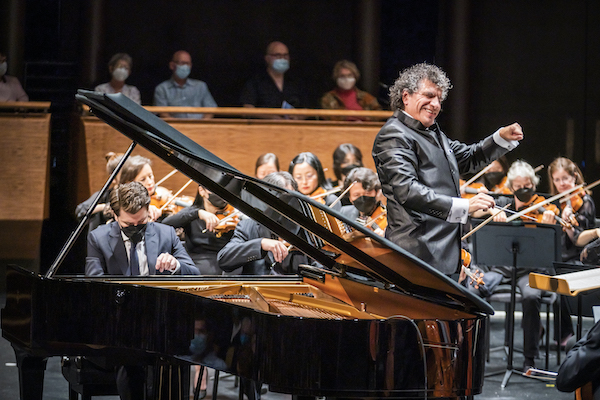Substitutes step up in Philharmonic’s evening with the Schumanns

Thursday night’s New York Philharmonic concert featured two debuts, neither of which had been planned or expected when the season opened.
The program was piano music from Clara and Robert Schumann, and Brahms’ Serenade No. 2. The scheduled pianist, Leif Ove Andsnes, could not get a visa in time, so the Philharmonic called on Alessio Bax to play Clara’s A minor Romanza, and Robert’s mighty Piano Concerto.
Then, earlier this week, the orchestra announced that music director Jaap van Zweden had to attend to a family medical emergency; Giancarlo Guerrero music director of the Nashville Symphony, took his place. Though these two musicians were new to the Philharmonic, they are both experienced artists with established careers.
In Rose Theater, the expected and the impromptu come together with wisdom and seasoning in a tidy, and often compelling, program. The tidiness was musical and also thematic—all the music was in A, moving from minor in the Romanza to major in the concerto and serenade. The pieces also came from the same household, or were at least connected to its center. Brahms was an important younger friend to the Schumanns, later spending his years in unrequited love for Clara after Robert’s death. This was a program in conversation with itself.
The Romanza is a small, fine piece based around a repeated theme with a call-and-response quality that opens up a beguiling internal dialogue, one that seems to disappear inside itself. Composed three years before Robert’s death, it reflects his balance of light and dark, and the succinct craft shows how fine a composer Clara was. This was a lovely solo piano performance, Bax shaping the melody with delicate adjustments of dynamics and the slightest bits of rubato.
More than just an introduction or setting a mood, this immediately opened up the conversation between composers and intimates, and it felt like the Schumanns were working together. The orchestra was on stage with Bax as he played the solo piece, and after the slightest pause, his attack on the opening chords of the concerto was sharp and vibrant. The Philharmonic followed with some of the warmest, grainiest, most colorful woodwind timbres one has heard from them this season.
Schumann’s Piano Concerto is one of the great masterpieces of its kind. The technical challenges are there, and Bax did miss a few notes, but with no meaningful consequences. The greater challenge is navigating the flow of moods and types of expression in the piece, which seems to cover the gamut of possible meanings while remaining focused and coherent.
This was an impressive and artistic performance from Bax, with the sense that he was there to give Schumann to the audience. His energy was focused on the effect of the music, and perhaps the most satisfying moments were in the first movement tuttis. The writing integrates piano and orchestra, and Bax kept his balance inside the group, the piano adding to the orchestration, rising above the surface only when the music demanded he speak in a solo voice.
The cadenza was intense, but felt less like a solo display than a continuation of Schumann’s through-line. Both Bax and Guerrero showed sound judgement with rubato and modulation of tempos, each decision adding to an accumulation of tension and feeling, and the segue out of the cadenza into the spectacular coda was an absolute thrill.
The Intermezzo was played with a sense of ease and intimacy; even though one never felt any rush, it seemed to be over in a flash—a true intermezzo. The finale had tremendous, bright energy, Bax playing with a spring in his hands and giving the rhythms and phrases a bounding feeling, like galloping over hills. This capped a wonderful performance, the kind that places the beauty, value, and meaning of the music before everything also.
After this magnificent music, the serenade, which Brahms composed a couple of years after Schumann’s death, sounded staid. This was an enormous space between sensations for the Philharmonic to traverse, and the reduced orchestra sounded sluggish in the opening movement. Compared to the Schumann’s sinuous, complex way with a line, Brahms is more orderly, at least on the surface, and it did take some time to adjust to the new mood—or at least the feeling of one mood at a time—after the drive and complex passions of Bax and the piano concerto.
That period of adjustment finished with the Scherzo. Up to that point the woodwinds maintained the pleasing blend from the concerto, and the smaller-sized ensemble fit right into the coziness of the Rose Theater.
With the Scherzo, the performance picked up energy and forward flow from Brahms’ subtle, powerful rhythms. Guerrero seemed to be enjoying himself, guiding the music without intervention. From that point, Brahms dominated the perceptions, and the lyricism of the Adagio and bounce of the Menuetto, were both a respite and a satisfaction in themselves.
This program will be repeated 8 p.m. Friday and Saturday. nyphil.org